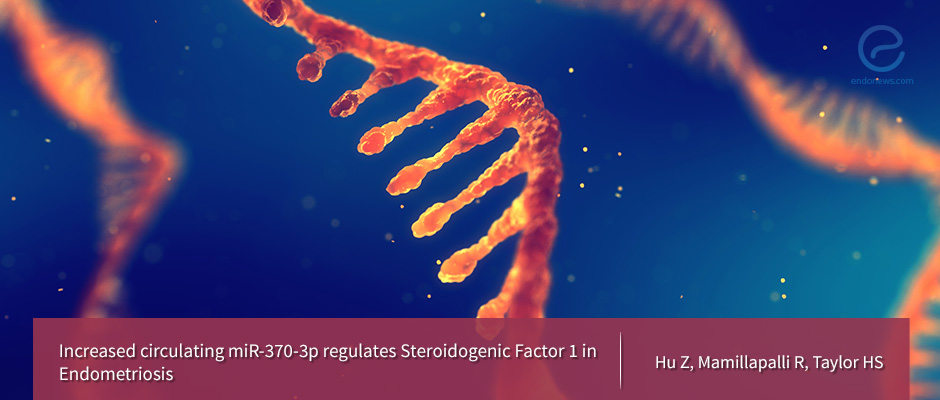The role of circulating microRNA's in Endometriosis
Jan 22, 2019
Increased circulating miR-370-3p regulates Steroidogenic Factor 1 in Endometriosis
Key Points
Highlight:
- miR-370-3p suppresses proliferation of endometriotic cells by regulating SF-1 .
Importance:
- The use of miR-370-3p to regulate SF-1 may provide a new therapeutic strategy for endometriosis.
Background:
- SF-1 is an essential transcriptional regulator coordinately regulating multiple genes involved in estrogen biosynthesis.
- SF-1 also plays an extraordinarily important role in the pathogenesis of endometriosis, but the underlying mechanism is not fully understood.
- Recently, miR-370 was reported to function as a tumor suppressor by targeting genes in various cancer cells.
- Here, Dr. Taylor group from Yale University identifies the interaction of SF-1 and miR-370 and determines whether miR-370 controlled the growth of endometriotic cells by regulating SF-1.
Key points:
- The expression of SF-1 and miR-370-3p are inversely proportional to each other in women with endometriosis.
- In primary endometriotic cells, miR-370-3p suppresses SF-1 expression.
- miR-370-3p further regulates the expression of SF-1 downstream genes such as StAR and CYP19A1.
- miR-370-3p inhibits cell proliferation and induces apoptosis in endometrial stromal cells.
- miR-370-3p functions as a negative regulator of Steroidogenic Factor 1 (SF-1) and cell proliferation in endometriotic cells.
Lay Summary
Endometriosis is an estrogen-dependent disorder. This disease affects approximately 10% of reproductive-aged women and 20% to 50% of infertile women.
Steroidogenic factor 1 (SF-1) is an essential transcriptional regulator coordinately regulating multiple genes involved in estrogen biosynthesis. SF-1 is known to play an extraordinarily important role in the pathogenesis of endometriosis. However, the mechanisms that regulate SF-1 expression in endometriosis are not fully understood.
MicroRNAs (miRNAs) are small single-stranded non-coding RNAs that can play important regulatory roles in animals. Recently, miR-370 was reported to function as a tumor suppressor in various cancer cells. Previous studies indicated that miR-370 was decreased in the serum of patients with endometriosis. However, the functions and mechanisms of miR-370 in endometriosis remain unclear.
In this study, Dr. Hugh S. Taylor's group from Yale University identifies the interaction of SF-1 and miR-370 and determines whether miR-370 controlled the growth of endometriotic cells by regulating SF-1. The paper appeared in American Journal of Physiology, Endocrinology, and Metabolism.
Firstly, this group confirmed the significantly increased SF-1 expression in endometriotic lesions. From miRNA microarray expression profiling analysis data, they identified that SF-1 and miR-370-3p are inversely expressive in endometriosis. In primary endometriotic cells, miR-370-3p suppresses SF-1 expression and its further downstream genes such as StAR and CYP19A1. By performing apoptosis analysis, miR-370-3p overexpression significantly inhibits cell proliferation and induces apoptosis in endometrial stromal cells.
In summary, Dr. Taylor group found that miR-370-3p acts to suppress proliferation by regulating SF-1 in endometriotic cells. The authors believe that the use of miR-370-3p to regulate SF-1 may provide a new therapeutic strategy for endometriosis.
Research Source: https://www.ncbi.nlm.nih.gov/pubmed/30576245
Endometriosis SF-1 miR-370-3p Apoptosis Cell proliferation

